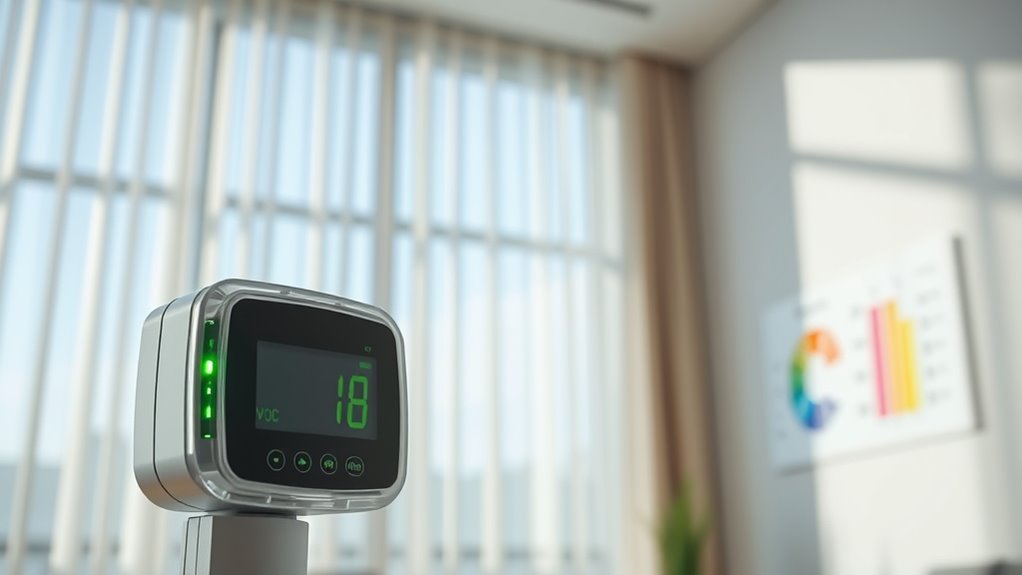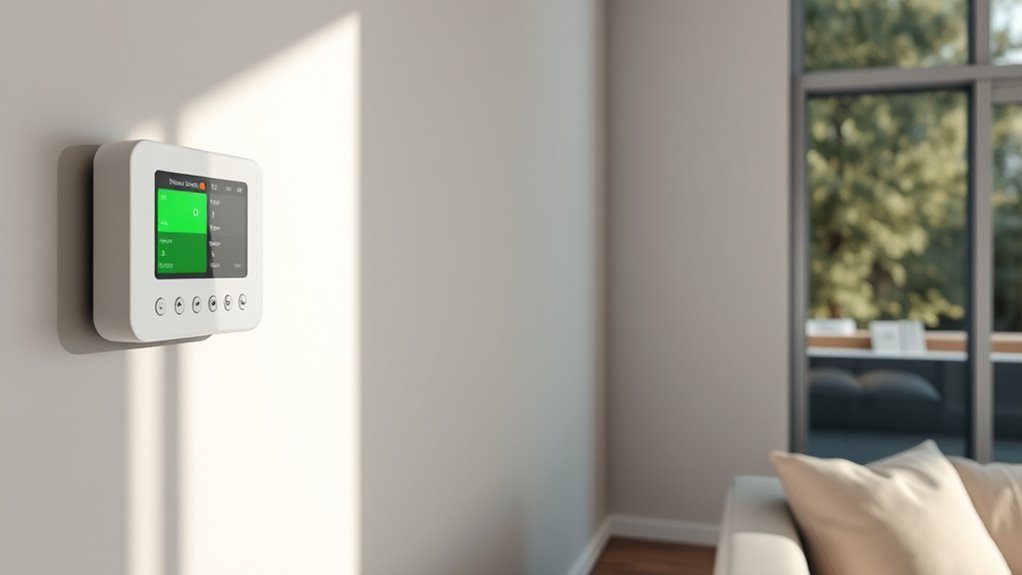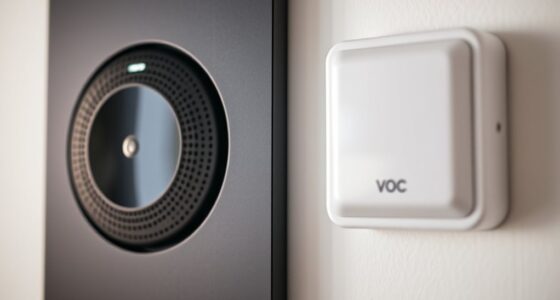To determine if VOC levels are safe, consider that the EPA recommends total VOC levels below 0.5 ppm in indoor air, while WHO guidelines vary for specific VOCs based on health risks. Standards are based on typical exposure durations and individual sensitivities. Monitoring these levels regularly can help you verify a healthy environment and prevent health issues. Keep exploring to understand how to measure and maintain safe VOC concentrations in your space.
Key Takeaways
- EPA recommends total VOC levels below 0.5 ppm for indoor air safety.
- WHO sets specific health-based thresholds for individual VOCs to prevent health risks.
- Safe VOC levels depend on exposure duration; short-term and long-term limits differ.
- Sensitivity varies among individuals; some may experience health issues at lower VOC concentrations.
- Regular monitoring helps ensure VOC levels stay within established safe guidelines for indoor environments.

Volatile Organic Compounds (VOCs) are common in many household products and building materials, but understanding whether their levels are safe can be confusing. As someone concerned about indoor air quality, you want to know if the air you breathe daily poses health risks. To do this, you need reliable VOC measurement techniques that give accurate readings of indoor air quality. These techniques help identify VOC concentrations and determine if they fall within safe limits or require action.
When evaluating VOC levels, it’s essential to understand how indoor air quality is affected. VOCs can originate from paints, cleaning supplies, woodworking, and even furniture, accumulating in indoor environments. The key is to measure these compounds precisely. Various VOC measurement techniques exist, including portable air quality monitors, passive badges, and laboratory analysis. Portable devices are useful for quick assessments; they provide real-time data that help you understand fluctuations in VOC levels throughout the day. Passive badges, on the other hand, are placed in a room over a period, capturing VOC exposure over time, which is valuable for identifying long-term trends. Laboratory analysis involves collecting air samples and sending them to specialized labs for detailed identification and quantification, offering the most accurate results but taking longer.
Understanding what VOC levels are considered safe depends on guidelines established by agencies like the Environmental Protection Agency (EPA) and the World Health Organization (WHO). These organizations set acceptable limits based on health risk assessments. For example, the EPA recommends that total VOC levels stay below 0.5 parts per million (ppm) in indoor air, although some specific VOCs have lower thresholds. It’s important to remember that these standards are based on typical exposure durations and may vary depending on individual sensitivities, such as allergies or respiratory conditions. Regular monitoring of indoor air quality can help detect VOCs early and prevent health issues, especially in sensitive populations.
Frequently Asked Questions
How Do VOC Levels Vary by Geographic Location?
You’ll notice VOC levels vary by geographic location due to differences in air quality and pollution sources. Urban areas with heavy traffic and industrial activity tend to have higher VOC concentrations, while rural regions often have lower levels. Local regulations and climate also influence VOC presence, affecting air quality. So, your environment plays a key role in VOC exposure, making it important to understand local pollution sources for better health awareness.
Can Individual Health Conditions Influence VOC Sensitivity?
Think of VOC sensitivity like a suit tailored for a unique body; your personal sensitivities can make you more vulnerable to health risks. If you have existing health conditions, you might experience stronger reactions even at lower VOC levels. So, it’s crucial to take into account your individual health profile, as what’s safe for one person might pose a significant health risk for another. Always listen to your body’s signals and seek advice if needed.
Are There Seasonal Changes in VOC Emissions?
You might notice seasonal fluctuations in VOC emissions, often higher during winter due to closed windows and reduced indoor ventilation. During colder months, indoor air can trap more VOCs from sources like heating and cleaning products. To minimize exposure, increase indoor ventilation when possible, especially in seasons with higher VOC emissions. Regularly airing out your space helps reduce indoor VOC levels and maintains healthier air quality year-round.
How Do VOC Levels Differ Between Indoor and Outdoor Environments?
Did you know indoor VOC levels can be 2 to 5 times higher than outdoor levels? Indoor air quality is often affected by VOC sources like cleaning products, paints, and furniture. These sources release harmful chemicals, making indoor environments potentially more hazardous. You should be aware that outdoor VOC levels fluctuate with traffic and weather, but indoor sources tend to be consistent, so managing indoor VOC sources is key to improving your air quality.
What Are the Long-Term Effects of Low-Level VOC Exposure?
You might not notice the long-term effects of low-level VOC exposure, but over time, it can influence indoor air quality and contribute to health issues like respiratory problems or headaches. Continuous exposure, often linked to indoor pollution sources, may also increase risks of more serious conditions. To protect yourself, guarantee good ventilation and reduce sources of VOCs, especially indoors where industrial pollution can accumulate unnoticed.
Conclusion
Remember, when it comes to VOC levels, “an ounce of prevention is worth a pound of cure.” Staying aware of safe VOC thresholds helps protect your health and environment. Keep ventilation good, choose low-VOC products, and regularly check indoor air quality. By taking these simple steps, you’re minimizing risks and creating a safer space for yourself and loved ones. After all, a little caution now can save you plenty of trouble later.









